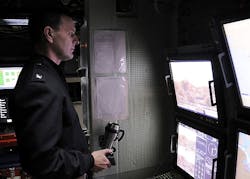L-3 KEO to build electro-optical photonics masts to aid stealthiness of Virginia-class submarine
WASHINGTON – U.S. Navy undersea warfare experts are enhancing the stealthiness and survivability of the nation's premiere fast-attack submarine fleet by equipping these vessels with improved sensor photonics masts.
Officials of the Naval Sea Systems Command in Washington on Friday announced an $8.7 million order to L-3 KEO (formerly Kollmorgen Electro-Optical) in Northampton, Mass., to build the Low Profile Photonics Mast (LPPM).
The LPPM aboard Navy Virginia-class attack submarines operates in place of the traditional submarine periscope. The photonics mast uses a variety of electro-optical sensors, and does not penetrate the submarine hull like a traditional periscope. Instead, photonics mast sensors connect to the submarine by optical fiber.
The LPPM is a low-observable optical mast that reduces the submarine's risk of detection by enemy submarines and surface warships while the system is in use, while improving the submarine's sensor capability. L-3 Communications acquired Kollmorgen Electro-Optical in 2012.
The LPPM is a modular non hull-penetrating imaging sensor sited in a telescoping universal modular mast bay that provides the submarine with improvements in stealth and survivability. Imagery from the LPPM is displayed on high-definition screens aboard the submarine.
Features include short-wave infrared (SWIR) and high-definition visual imaging, laser range finding, special stealth features, and an antenna suite with broad spectral coverage and direction finding. SWIR sensors particularly are adept at penetrating fog, haze, and other obscurants.
Just last week L-3 KEO won a $19.3 million contract to provide additional Universal Modular Mast (UMM) systems for Navy Virginia-class attack submarines. The UMM serves as a lifting mechanism for Virginia class mast-mounted sensor payloads.
Four years ago L-3 KEO won an $111.8 million contract to develop LPPM prototypes. At the time Navy Chief of Naval Operations Adm. Jonathan Greenert asked for all Pacific Fleet Virginia-class submarines to be equipped with the LPPM to support sensitive missions vital to national security.
LPPM prototypes initially were developed without the installation and spares necessary to support deployments and were intended only for integration and testing as part of local operations, Navy officials say.
Production LPPM masts were not to be made available until last year. Previous to that, LPPM prototypes were installed on deploying Virginia-class submarines as one way to provide fast LPPM capability.
On Friday's order L-3 KEO will do the work in Northampton, Mass., and should be finished by March 2021. For more information contact L-3 KEO online at www2.l3t.com/keo, or Naval Sea Systems Command at www.navsea.navy.mil.
Ready to make a purchase? Search the Military & Aerospace Electronics Buyer's Guide for companies, new products, press releases, and videos

John Keller | Editor
John Keller is editor-in-chief of Military & Aerospace Electronics magazine, which provides extensive coverage and analysis of enabling electronic and optoelectronic technologies in military, space, and commercial aviation applications. A member of the Military & Aerospace Electronics staff since the magazine's founding in 1989, Mr. Keller took over as chief editor in 1995.

